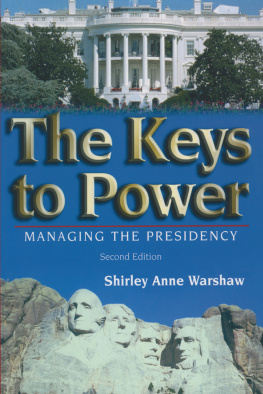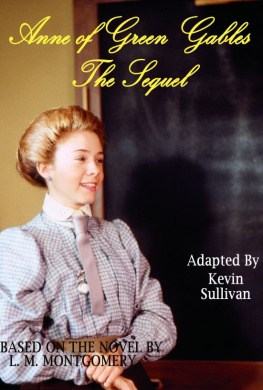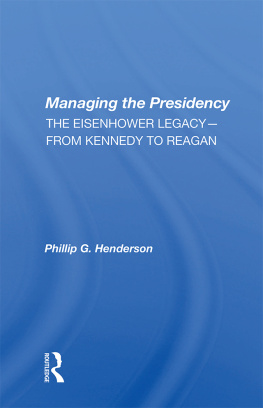Shirley Anne Warshaw - The Keys to Power: Managing the Presidency
Here you can read online Shirley Anne Warshaw - The Keys to Power: Managing the Presidency full text of the book (entire story) in english for free. Download pdf and epub, get meaning, cover and reviews about this ebook. year: 2015, publisher: Routledge, genre: Politics. Description of the work, (preface) as well as reviews are available. Best literature library LitArk.com created for fans of good reading and offers a wide selection of genres:
Romance novel
Science fiction
Adventure
Detective
Science
History
Home and family
Prose
Art
Politics
Computer
Non-fiction
Religion
Business
Children
Humor
Choose a favorite category and find really read worthwhile books. Enjoy immersion in the world of imagination, feel the emotions of the characters or learn something new for yourself, make an fascinating discovery.
- Book:The Keys to Power: Managing the Presidency
- Author:
- Publisher:Routledge
- Genre:
- Year:2015
- Rating:5 / 5
- Favourites:Add to favourites
- Your mark:
- 100
- 1
- 2
- 3
- 4
- 5
The Keys to Power: Managing the Presidency: summary, description and annotation
We offer to read an annotation, description, summary or preface (depends on what the author of the book "The Keys to Power: Managing the Presidency" wrote himself). If you haven't found the necessary information about the book — write in the comments, we will try to find it.
The Keys to Power: Managing the Presidency — read online for free the complete book (whole text) full work
Below is the text of the book, divided by pages. System saving the place of the last page read, allows you to conveniently read the book "The Keys to Power: Managing the Presidency" online for free, without having to search again every time where you left off. Put a bookmark, and you can go to the page where you finished reading at any time.
Font size:
Interval:
Bookmark:
to Power
Gettysburg College

2 Park Square, Milton Park, Abingdon, Oxon OX14 4RN
711 Third Avenue, New York, NY 10017, USA
Product or corporate names may be trademarks or registered trademarks, and are used only for identification and explanation without intent to infringe.
The Keys to power : managing the presidency / Shirley Anne Warshaw. 2nd ed.
p. cm.
Includes bibliographical references and index.
ISBN 0-321-08877-8 (alk. paper)
1. PresidentsUnited States. 2. PresidentsUnited StatesDecision making. 3. Political
planningUnited States. I. Title.
JK516.W374 2004
352.230973dc22
2004023433
of the Presidency
and Elections
TABULATIONS
Election Campaign Act
LEADER AND THE ABSENCE OF VETOES
(1983)
Affairs
CENTRAL CLEARANCE
Proposals
RICHARD M. NIXON (1974)
WILLIAM JEFFERSON CLINTON (1998)
PRESIDENTIAL LEADERSHIP
POWER
COURT-PACKING BILL FIRESIDE CHAT, MARCH 9, 1937
Rulings
Action
Policies
Through Polling
Opinion
Vice President
VICE PRESIDENTS
Gore, and Cheney
CABINET RANK
Power
the Cabinet
Officers
Administration
Present
Assignments
of the President
GEORGE W. BUSH
Committee
(Bureau of the Budget)
Board
BOARD
Bureaucracy
Programs
Bureaucracy
Bureaucracy
Management
19811999
Vice President
George W. Bush
Election Years
Font size:
Interval:
Bookmark:
Similar books «The Keys to Power: Managing the Presidency»
Look at similar books to The Keys to Power: Managing the Presidency. We have selected literature similar in name and meaning in the hope of providing readers with more options to find new, interesting, not yet read works.
Discussion, reviews of the book The Keys to Power: Managing the Presidency and just readers' own opinions. Leave your comments, write what you think about the work, its meaning or the main characters. Specify what exactly you liked and what you didn't like, and why you think so.












